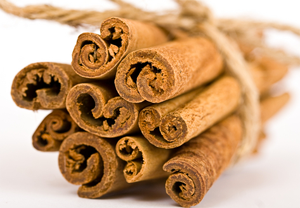 If you live in North America or Europe that jar of ”cinnamon” in your cupboard is probably not truly cinnamon at all, but a very similar spice known as cassia or ”bastard cinnamon.” True cinnamon is usually labeled ”Ceylon cinnamon” and comes principally from Sri Lanka, India, Madagascar, Brazil and the Caribbean. Cassia, on the other hand, is often designated as ”Chinese cinnamon” or ”Saigon cinnamon” and comes principally from Indonesia, China, Vietnam, Japan and Korea.
If you live in North America or Europe that jar of ”cinnamon” in your cupboard is probably not truly cinnamon at all, but a very similar spice known as cassia or ”bastard cinnamon.” True cinnamon is usually labeled ”Ceylon cinnamon” and comes principally from Sri Lanka, India, Madagascar, Brazil and the Caribbean. Cassia, on the other hand, is often designated as ”Chinese cinnamon” or ”Saigon cinnamon” and comes principally from Indonesia, China, Vietnam, Japan and Korea.
Written By: Margie King, Greenmedinfo.com | Source article
Cinnamon is one of the oldest spices and most popular spices, and has been used for millennia both for its flavoring and medicinal qualities. In ancient Egypt, it was used to fill body cavities of corpses as an embalming agent. In ancient Rome it was considered so valuable that the Emperor Nero burned a year’s supply on his wife’s funeral pyre as proof of his devotion to her.
Ceylon cinnamon is more expensive and more difficult to find in North American where most spices labeled cinnamon are actually the cheaper cassia. Sweeter, lighter and more refined than cassia, true cinnamon is most suitable to flavoring desserts rather than more robust, savory dishes which can handle the heavier cassia.
Besides flavor, the most important distinction between the two spices, however, is in their levels of coumarin, natural compound that acts as a blood thinner when ingested.
Cassia has much higher levels of coumarin than true cinnamon. Patients on blood thinners such as warfarin (trade name Coumadin) are often advised to limit their intake of cinnamon, but this generally applies to cassia more so than to real cinnamon.
Both types of cinnamon are excellent sources of the trace mineral manganese which is an important activator of enzymes essential to building healthy bones as well as other physiological processes, including carbohydrate and fat metabolism.
They are also both very good sources of dietary fiber, iron and calcium. The combination of calcium and fiber is thought to be helpful in reducing the risk of colon cancer and lowering cholesterol levels, and relieving constipation or diarrhea.
Six reasons to eat cinnamon every day
Cinnamon lowers blood sugar levels
Cinnamon has been shown to normalize blood sugar levels in type 2 diabetics by improving the ability to respond to insulin. It does so in part by slowing the rate at which the stomach empties after eating as evidenced by a study in which people ate about a cup of rice pudding with and without about a teaspoon of cinnamon. Adding the cinnamon slowed the rate the stomach emptied from 37% to 34.5% and significantly slowed the rise in blood sugar levels. Even less than a half of a teaspoon a day reduces blood sugar levels in type 2 diabetics.
Cinnamon lowers cholesterol
Diabetics can also reduce their risk factors associated with cardiovascular disease by consuming even one daily gram (about 1/3 teaspoon) of cinnamon. One 2003 USDA study found that after 40 days of eating between just 1 and 6 grams of cinnamon (about 2 teaspoons), type 2 diabetics were not only able to reduce their blood sugar levels by 18-29%, but also lowered their triglycerides by 23-30%, their LDL (bad) cholesterol by 7 to 27% and total cholesterol by 12-26%.
Cinnamon supports healthy blood clotting
Much research has been devoted to cinnamon’s effect on blood platelets which contribute to clotting. It helps thin the blood and prevent unwanted clumping of platelets. It is so effective as an anti-coagulant that patients taking prescription blood thinners are warned not to take cinnamon in concentrated form such as supplements or extracts.
Cinnamon fights bacteria and fungus
Ayurvedic medicine has long used cinnamon for it anti-microbial qualities to support the immune system and prevent colds and flu. It has been proven to help stop the growth of bacteria, fungus and the common yeast Candida. One study showed that it is an effective alternative to chemical food preservatives and just a few drops of essential oil of cinnamon added to refrigerated carrot broth prevented the growth of food-borne pathogens for up to 60 days.
Cinnamon boosts memory and protects the brain
Chewing cinnamon flavored gum or just smelling the sweet spice has been found to improve brain activity. Research led by Dr. P. Zoladz and presented at the 2004 meeting of the Association for Chemoreception Sciences, in Sarasota, Florida concluded that cinnamon enhances cognitive processing and was found to improve test subjects scores related to attention, memory and visual-motor speed when working at a computer.
A 2011 study suggested that it may have a role in reducing the kind of chronic inflammation that leads to various neurodegenerative diseases, such as Alzheimer’s disease, Parkinson’s disease, multiple sclerosis, brain tumor, and meningitis.
Cinnamon improves digestion
In traditional Chinese medicine, cinnamon has been used for flatulence, nausea and diarrhea. It is also believed to improve the body’s ability to digest fruit, milk and other dairy products.
Both cassia and real cinnamon are often labeled the same in North America. The true Ceylon version will be more expensive, and it will be a lighter shade of brown, a finer powder and have a sweeter scent. When buying the sticks, known as ”quills,” keep in mind that, generally, cassia will be thicker and the two ends will be rolled toward each other rather than being rolled in one direction only.
Written By: Margie King, Greenmedinfo.com | Source article
About the author. Margie King is a holistic health coach and graduate of the Institute for Integrative Nutrition®. A Wharton M.B.A. and practicing corporate attorney for 20 years, Margie left the world of business to pursue her passion for all things nutritious. She now works with midlife women and busy professionals to improve their health, energy and happiness through individual and group coaching, as well as webinars, workshops and cooking classes. She is also a professional copywriter and prolific health and nutrition writer whose work appears as the National Nutrition Examiner. To contact Margie, visit NourishingMenopause.com [13].
Disclaimer: This article is not intended to provide medical advice, diagnosis or treatment. Views expressed here do not necessarily reflect those of GreenMedInfo or its staff.
Also read: 12 Health Benefits of Cinnamon?

 NewsVoice är en nättidning för oberoende nyheter, debatt och analys.
NewsVoice är en nättidning för oberoende nyheter, debatt och analys. 
